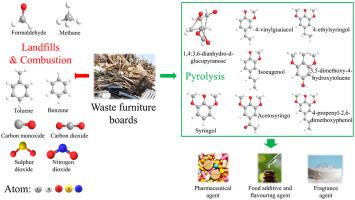Journal of Hazardous Materials ( IF 12.2 ) Pub Date : 2021-07-29 , DOI: 10.1016/j.jhazmat.2021.126774 Shin Ying Foong 1 , Rock Keey Liew 2 , Chern Leing Lee 3 , Wei Peng Tan 4 , Wanxi Peng 5 , Christian Sonne 6 , Yiu Fai Tsang 7 , Su Shiung Lam 1

|
Waste furniture boards (WFBs) contain hazardous formaldehyde and volatile organic compounds when left unmanaged or improperly disposed through landfilling and open burning. In this study, pyrolysis was examined as a disposal and recovery approach to convert three types of WFBs (i.e., particleboard, plywood, and fiberboard) into value-added chemicals using thermogravimetric analysis coupled with Fourier-transform infrared spectrometry (TG-FTIR) and pyrolysis coupled with gas chromatography/mass spectrometry (Py-GC/MS). TG-FTIR analysis shows that pyrolysis performed at an optimum temperature of 250–550 °C produced volatile products mainly consisting of carbon dioxide, carbon monoxide, and light hydrocarbons, such as methane. Py-GC/MS shows that pyrolysis at different final temperatures and heating rates recovered mainly phenols (25.9–54.7%) for potential use as additives in gasoline, colorants, and food. The calorific value of WFBs ranged from 16 to 18 MJ/kg but the WFBs showed high H/C (1.7–1.8) and O/C (0.8–1.0) ratios that provide low chemical energy during combustion. This result indicates that WFBs are not recommended to be burned directly as fuel, however, they can be pyrolyzed and converted into solid pyrolytic products such as biochar with improved properties for fuel application. Hazardous components, such as cyclopropylmethanol, were removed and converted into value-added compounds, such as 1,4:3,6-dianhydro-d-glucopyranose, for use in pharmaceuticals. These results show that the pyrolysis of WFBs at high temperature and low heating rate is a promising feature to produce value-added chemicals and reduce the formation of harmful chemical species. Thus, the release of hazardous formaldehyde and greenhouse gases into the environment is redirected.
中文翻译:

通过热解减少废旧家具板的战略危害:热解行为、机制和增值产品
废弃家具板 (WFB) 含有有害的甲醛和挥发性有机化合物,如果不加以管理或通过填埋和露天焚烧处理不当。在这项研究中,热解被视为一种处置和回收方法,使用热重分析结合傅里叶变换红外光谱 (TG-FTIR) 和热解与气相色谱/质谱联用 (Py-GC/MS)。TG-FTIR 分析表明,在 250-550 °C 的最佳温度下进行热解产生的挥发性产物主要由二氧化碳、一氧化碳和轻烃(如甲烷)组成。Py-GC/MS 显示在不同的最终温度和加热速率下热解主要回收苯酚 (25.9–54. 7%) 可能用作汽油、着色剂和食品中的添加剂。WFB 的热值范围为 16 到 18 MJ/kg,但 WFB 显示出高 H/C (1.7-1.8) 和 O/C (0.8-1.0) 比,在燃烧过程中提供低化学能。该结果表明,不建议将 WFBs 直接作为燃料燃烧,但是,它们可以被热解并转化为固体热解产物,例如具有改进的燃料应用特性的生物炭。有害成分,如环丙基甲醇,被去除并转化为增值化合物,如 1,4:3,6-二脱水- 该结果表明,不建议将 WFBs 直接作为燃料燃烧,但是,它们可以被热解并转化为固体热解产物,例如具有改进的燃料应用特性的生物炭。有害成分,如环丙基甲醇,被去除并转化为增值化合物,如 1,4:3,6-二脱水- 该结果表明,不建议将 WFBs 直接作为燃料燃烧,但是,它们可以被热解并转化为固体热解产物,例如具有改进的燃料应用特性的生物炭。有害成分,如环丙基甲醇,被去除并转化为增值化合物,如 1,4:3,6-二脱水-d-吡喃葡萄糖,用于药物。这些结果表明,WFBs 在高温和低加热速率下的热解是生产高附加值化学品和减少有害化学物质形成的一个有前途的特征。因此,有害甲醛和温室气体向环境中的释放被重定向。











































 京公网安备 11010802027423号
京公网安备 11010802027423号